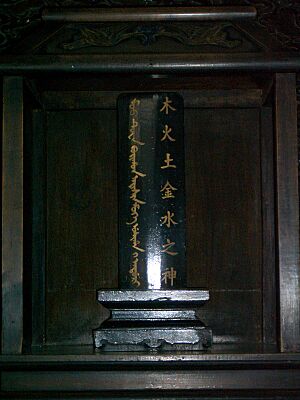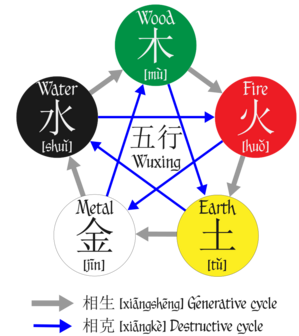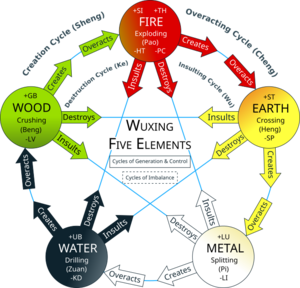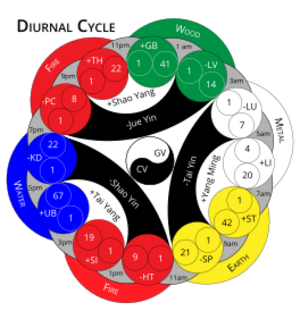Wuxing (Chinese philosophy) facts for kids
Quick facts for kids Wuxing |
|||||||||||||||||||||||
|---|---|---|---|---|---|---|---|---|---|---|---|---|---|---|---|---|---|---|---|---|---|---|---|
| Chinese | 五行 | ||||||||||||||||||||||
|
|||||||||||||||||||||||
| ngũ hành | |
| Vietnamese alphabet | ngũ hành |
|---|---|
| Chữ Hán | 五行 |

Wuxing (Chinese: 五行; pinyin: wǔxíng) is an ancient Chinese idea that helps explain how the world works. It is often translated as the Five Phases or Five Transformations. It's not about five simple materials, but about five powerful, changing forces that are connected to everything.
These five phases are:
- Wood (Chinese: 木; pinyin: mù)
- Fire (Chinese: 火; pinyin: huǒ)
- Earth (Chinese: 土; pinyin: tǔ)
- Metal (Chinese: 金; pinyin: jīn)
- Water (Chinese: 水; pinyin: shuǐ)
This idea has been a big part of Chinese culture for over two thousand years. It is used in many areas, like traditional Chinese medicine, feng shui (the art of arranging spaces), Chinese martial arts, and even in understanding history and nature. The Five Phases show how different parts of the universe are linked and are always changing in cycles.
Contents
What Does "Wuxing" Mean?

The word Wuxing is made of two Chinese characters.
- Wǔ (五) means "five."
- Xíng (行) means "moving," "changing," or "walking."
So, Wuxing means the "five movements" or "five changes." This name was chosen because the ancient Chinese first connected these phases to the five planets they could see moving in the night sky: Jupiter (Wood), Mars (Fire), Saturn (Earth), Venus (Metal), and Mercury (Water).
Unlike the four classical elements in ancient Greece (earth, water, air, fire), which were seen as the basic substances that make things, the Wuxing are more about process and change. For example, the "Wood" phase isn't just about physical wood. It represents the energy of growth, springtime, and new beginnings, like a tree growing tall.
How the Five Phases Work Together
The Five Phases are connected in two main ways, called cycles. These cycles show how the phases can either help or control each other to keep the world in balance.
The Generating Cycle: Helping Each Other
This cycle is also called the "mother-son" cycle because each phase helps create the next one, just like a mother gives life to a child.
- Wood feeds Fire. (Burning wood creates fire.)
- Fire creates Earth. (Ash from a fire becomes part of the earth.)
- Earth bears Metal. (Metals and minerals are found in the earth.)
- Metal carries Water. (Metal can be made into a container to hold water, or water drops can form on a cool metal surface.)
- Water nourishes Wood. (Water helps trees and plants grow.)
The Controlling Cycle: Keeping Balance
This cycle is also called the "grandfather-grandson" cycle. It shows how each phase can control another to prevent any one phase from becoming too powerful. This creates balance.
- Wood holds Earth in place. (Tree roots prevent soil from washing away.)
- Earth contains Water. (The banks of a river or a dam hold back water.)
- Water puts out Fire.
- Fire melts Metal.
- Metal chops Wood. (An axe can cut down a tree.)
Wuxing in Culture and Daily Life
The idea of the Five Phases is used in many interesting ways in Chinese culture.
Connecting to Nature and Seasons
Each phase is linked to different parts of nature, creating a map of the universe. This includes seasons, directions, colors, and even planets.
| Phase | Planet | Color | Season | Direction |
|---|---|---|---|---|
| Wood | Jupiter | Green | Spring | East |
| Fire | Mars | Red | Summer | South |
| Earth | Saturn | Yellow | Change of Seasons | Center |
| Metal | Venus | White | Autumn | West |
| Water | Mercury | Black | Winter | North |
Feng Shui: Arranging Your Space
Feng shui is the ancient Chinese art of arranging buildings, objects, and space to achieve harmony and balance. Practitioners of feng shui use the Five Phases to understand the flow of energy, or qi, in a place. By arranging furniture, colors, and materials according to the generating and controlling cycles, they believe they can create a healthier and happier environment.
A Guide for Ancient Doctors
In Traditional Chinese medicine, doctors use the Five Phases to understand how different parts of the body are connected. Each phase is linked to certain organs, emotions, and senses. By understanding these connections, a doctor could figure out why someone was sick and how to bring their body back into balance.
For example:
- Wood is linked to the liver, eyes, and the emotion of anger.
- Fire is linked to the heart, tongue, and the emotion of joy.
- Earth is linked to the spleen, mouth, and the emotion of worry.
- Metal is linked to the lungs, nose, and the emotion of sadness.
- Water is linked to the kidneys, ears, and the emotion of fear.
Music and Sounds
The Five Phases are also connected to the five notes of the ancient Chinese musical scale, which is a pentatonic scale. Each note has a unique sound and feeling that matches the energy of its phase.
| Phase | Wood | Fire | Earth | Metal | Water |
|---|---|---|---|---|---|
| Chinese Note | 角 (jué) | 徵 (zhǐ) | 宮 (gōng) | 商 (shāng) | 羽 (yǔ) |
| Western Note (approx.) | Mi (E) | Sol (G) | Do (C) | Re (D) | La (A) |
See also
- Acupuncture
- Classical element
- Color in Chinese culture
- Flying Star Feng Shui
- Humorism
- Qi
- Yin and yang




